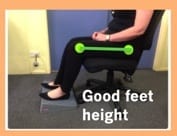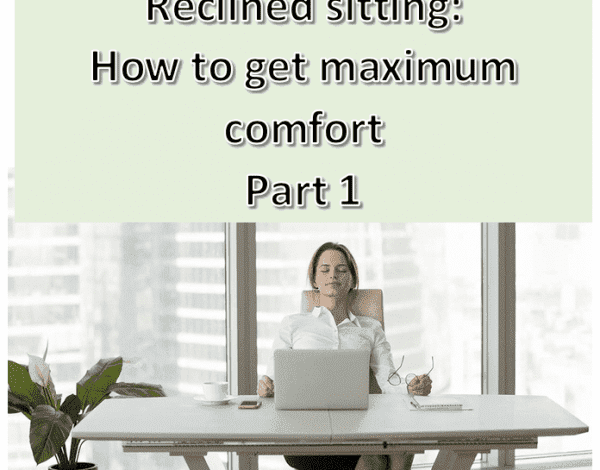Getting your chair height right for you!
We all have different leg lengths and if we don’t get the height of our feet correct we can often find ourselves uncomfortable and fidgeting. This is where you might start to place your feet on the chair star base; having to repeatedly sit back into the chair because you keep sliding out or lean forward and lean onto the desk surface. This is because your feet are too low and gravity keeps causing you to slide out of the chair!
So move your chair away from your desk and try the following adjustments
- Adjust your chair to its lowest position.
- Sit as far back in the chair as possible and adjust the backrest height so that there is sufficient space for your backside to fit. (there needs to be a gap between the seat base and the backrest for your buttocks). This allows you to make good contact with the backrest

- The length of the seat base should allow 2-3 finger gap between the front edge of your seat and the back of the knee. If your seat has a slide mechanism you can lengthen or shorten to achieve this gap. This will ensure good thigh support.
- Adjust the backrest angle so that you lean back. Try to achieve a trunk to thigh angle of about 100º-115º. This open reclined sitting angle will allow your lumbar curve to return. (sitting up straight in a 90º angle will flatten the lumbar curve and increase pressure on your spinal discs).

- Now check whether your thighs are parallel to the floor. If so this is a good chair height for you. If your knees are a little higher than your hip height, then this will be ok too as gravity will then keep you in the chair. If your knees are a lot higher than your hips, simply raise the chair to achieve the parallel or slightly higher knees. And if your knees are still lower than your hips, then go to the next step as you are going to continue to slide off the chair
- Find yourself something to place your feet on that will raise your whole foot. It may be a ream of paper or 2; shoe boxes, some books or a rolled up yoga mat; any thing that will get your knee and hip height similar.
 Now for the desk challenge…. If your desk is height adjustable, just lower the desk down to where you’re resting your arms on the desk top (see Office Ergonomics Part 2: Reclined Sitting & how to get maximum comfort – (the upper half of your body)). If you feel too low, which is a common problem, then raise your chair to where your forearms are resting on your desk top. Then again check your feet height. If you did raise yourself you may have to add a little bit more height to the foot rest support; just get those knees parallel to the hips at a minimum.
Now for the desk challenge…. If your desk is height adjustable, just lower the desk down to where you’re resting your arms on the desk top (see Office Ergonomics Part 2: Reclined Sitting & how to get maximum comfort – (the upper half of your body)). If you feel too low, which is a common problem, then raise your chair to where your forearms are resting on your desk top. Then again check your feet height. If you did raise yourself you may have to add a little bit more height to the foot rest support; just get those knees parallel to the hips at a minimum.
Play with the height of your feet; you will see that as you raise your knee slightly above the hip height, you will recline into the backrest even more, thus keeping the trunk to thigh angle greater than 100º and thus you will improve the overall shape of your spine and keep those curves naturally in place.
Now let’s work on the top half of the body and how to get this comfortable. we will show you this in:
Office Ergonomics Part 2: Reclined Sitting & how to get maximum comfort – (the upper half of your body)
If you would like to see a video of this setup please click on the following link:
References:
Aras et al. (1998) Musculoskeletal, visual and pshychosocial stress in VDU operators before & after multidisciplinary ergonomic interventions App Erg,29(5),335-360
Aras et al (2001) as above: a 6 year prospective study.App Erg,32,559-571
Cook et al (2004) The effect of forearm support on musculoskeletal discomfort during call centre work. App Erg, 35(4),337-342
Cook et al (2004) The effect of upper extremity posture & muscle activity during keyboard use. App Erg, 35, 285-292.
Grandjean et al (1983), VDT workstation design: preferred settings and their effects” Human Factors


